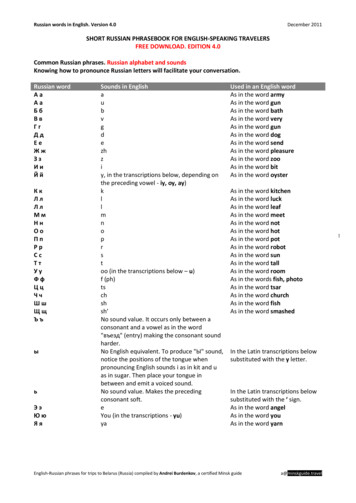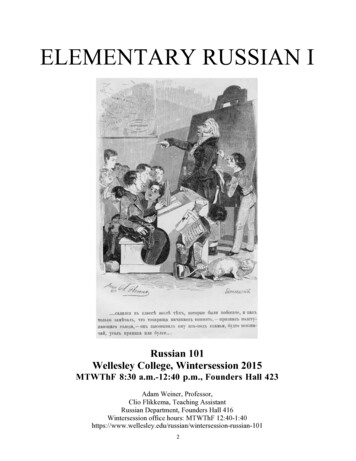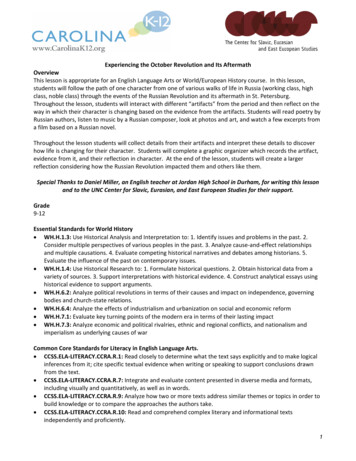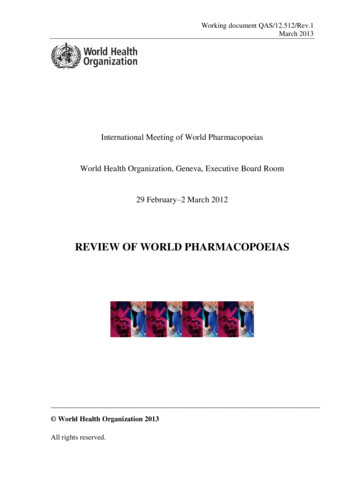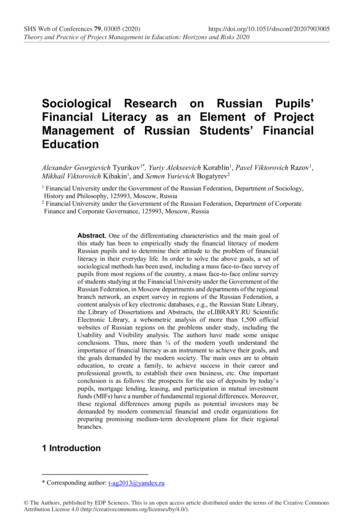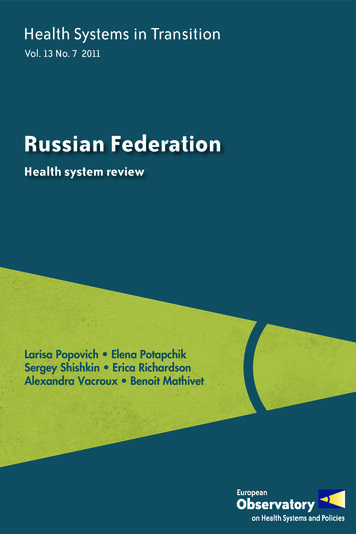
Transcription
Health Systems in TransitionVol. 13 No. 7 2011Russian FederationHealth system reviewLarisa Popovich Elena PotapchikSergey Shishkin Erica RichardsonAlexandra Vacroux Benoit Mathivet
Erica Richardson (Editor) and Martin McKee (Series editor)were responsible for this HiTEditorial BoardEditor in chiefElias Mossialos, London School of Economics and Political Science, United KingdomSeries editorsReinhard Busse, Berlin University of Technology, GermanyJosep Figueras, European Observatory on Health Systems and PoliciesMartin McKee, London School of Hygiene & Tropical Medicine, United KingdomRichard Saltman, Emory University, United StatesEditorial teamSara Allin, University of Toronto, CanadaJonathan Cylus, European Observatory on Health Systems and PoliciesMatthew Gaskins, Berlin University of Technology, GermanyCristina Hernández-Quevedo, European Observatory on Health Systems and PoliciesMarina Karanikolos, European Observatory on Health Systems and PoliciesAnna Maresso, European Observatory on Health Systems and PoliciesDavid McDaid, European Observatory on Health Systems and PoliciesSherry Merkur, European Observatory on Health Systems and PoliciesPhilipa Mladovsky, European Observatory on Health Systems and PoliciesDimitra Panteli, Berlin University of Technology, GermanyBernd Rechel, European Observatory on Health Systems and PoliciesErica Richardson, European Observatory on Health Systems and PoliciesAnna Sagan, European Observatory on Health Systems and PoliciesSarah Thomson, European Observatory on Health Systems and PoliciesEwout van Ginneken, Berlin University of Technology, GermanyInternational advisory boardTit Albreht, Institute of Public Health, SloveniaCarlos Alvarez-Dardet Díaz, University of Alicante, SpainRifat Atun, Global Fund, SwitzerlandJohan Calltorp, Nordic School of Public Health, SwedenArmin Fidler, The World BankColleen Flood, University of Toronto, CanadaPéter Gaál, Semmelweis University, HungaryUnto Häkkinen, Centre for Health Economics at Stakes, FinlandWilliam Hsiao, Harvard University, United StatesAlan Krasnik, University of Copenhagen, DenmarkJoseph Kutzin, World Health Organization Regional Office for EuropeSoonman Kwon, Seoul National University, Republic of KoreaJohn Lavis, McMaster University, CanadaVivien Lin, La Trobe University, AustraliaGreg Marchildon, University of Regina, CanadaAlan Maynard, University of York, United KingdomNata Menabde, World Health Organization Regional Office for EuropeEllen Nolte, Rand Corporation, United KingdomCharles Normand, University of Dublin, IrelandRobin Osborn, The Commonwealth Fund, United StatesDominique Polton, National Health Insurance Fund for Salaried Staff (CNAMTS), FranceSophia Schlette, Health Policy Monitor, GermanyIgor Sheiman, Higher School of Economics, Russian FederationPeter C. Smith, Imperial College, United KingdomWynand P.M.M. van de Ven, Erasmus University, The NetherlandsWitold Zatonski, Marie Sklodowska-Curie Memorial Cancer Centre, Poland
Health Systemsin TransitionLarisa Popovich, Institute for Health Economics, State University, MoscowElena Potapchik, Institute for Health Economics, State University, MoscowSergey Shishkin, Institute for Health Economics, State University, MoscowErica Richardson, European Observatory on Health Systems and PoliciesAlexandra Vacroux, Harvard University, Cambridge, United StatesBenoit Mathivet, World Health Organization Country Office in TajikistanRussian Federation:Health System Review2011The European Observatory on Health Systems and Policies is a partnershipbetween the World Health Organization Regional Office for Europe, theGovernments of Belgium, Finland, Ireland, the Netherlands, Norway, Slovenia,Spain, Sweden and the Veneto Region of Italy, the European Commission,the European Investment Bank, the World Bank, UNCAM (French NationalUnion of Health Insurance Funds), the London School of Economics andPolitical Science, and the London School of Hygiene & Tropical Medicine.
Keywords:DELIVERY OF HEALTH CAREEVALUATION STUDIESFINANCING, HEALTHHEALTH CARE REFORMHEALTH SYSTEM PLANS – organization and administrationRUSSIAN FEDERATION World Health Organization 2011, on behalf of theEuropean Observatory on Health Systems and PoliciesAll rights reserved. The European Observatory onHealth Systems and Policies welcomes requests forpermission to reproduce or translate its publications,in part or in full.Please address requests about the publication to:Publications,WHO Regional Office for Europe,Scherfigsvej 8,DK-2100 Copenhagen Ø, DenmarkThe designations employed and the presentation of thematerial in this publication do not imply the expressionof any opinion whatsoever on the part of the EuropeanObservatory on Health Systems and Policies or any ofits partners concerning the legal status of any country,territory, city or area or of its authorities, or concerningthe delimitation of its frontiers or boundaries. Where thedesignation “country or area” appears in the headings oftables, it covers countries, territories, cities, or areas.Dotted lines on maps represent approximate border linesfor which there may not yet be full agreement.Alternatively, complete an online requestform for documentation, health information,or for permission to quote or translate,on the Regional Office web site(http://www.euro.who.int/pubrequest)The mention of specific companies or of certainmanufacturers’ products does not imply that they areendorsed or recommended by the European Observatoryon Health Systems and Policies in preference to othersof a similar nature that are not mentioned. Errors andomissions excepted, the names of proprietary productsare distinguished by initial capital letters.The views expressed by authors or editors do notnecessarily represent the decisions or the statedpolicies of the European Observatory on HealthSystems and Policies or any of its partners.The European Observatory on Health Systems and Policiesdoes not warrant that the information contained in thispublication is complete and correct and shall not be liablefor any damages incurred as a result of its use.Printed and bound in the United Kingdom.Suggested citation:Popovich L, Potapchik E, Shishkin S, Richardson E, Vacroux A, andMathivet B. Russian Federation: Health system review. Health Systemsin Transition, 2011; 13(7):1–190.ISSN 1817-6127 Vol. 13 No. 7
ContentsContentsPreface vAcknowledgements viiList of abbreviations ixList of tables, figures and boxes xiAbstract xiiiExecutive summary xv1. Introduction 11.1 Geography and sociodemography 11.2 Economic context 31.3 Political context 61.4 Health status 92. Organization and governance 2.1 Overview of the health system 2.2 Historical background 2.3 Organization 2.4 Decentralization and centralization 2.5 Planning 2.6 Health information management 2.7 Regulation 2.8 Patient empowerment 1313142140424751623. Financing 3.1 Health expenditure 3.2 Revenue collection/sources of funds 3.3 Overview of the statutory financing system 3.4 Out-of-pocket payments 3.5 VHI 3.6 Other financing 3.7 Payment mechanisms 6767727585888989
ivHealth systems in transition Russian Federation4. Physical and human resources 954.1 Physical resources 954.2 Human resources 1025. Provision of services 1115.1 Public health 1115.2 Patient pathways 1125.3 Primary/ambulatory care 1125.4 Secondary care (specialized ambulatory care/inpatient care) 1195.5 Emergency care 1225.6 Pharmaceutical care 1245.7 Rehabilitation/intermediate care 1295.8 Long-term care 1315.9 Palliative care 1335.10 Mental health care 1335.11 Dental care 1366. Principal health reforms 1376.1 Analysis of recent reforms 1376.2 Future developments 1597. Assessment of the health system 1657.1 Stated objectives of the health system 1657.2 Financial protection and equity in financing 1657.3 User experience and equity of access to health care 1667.4 Health outcomes, health service outcomes and quality of care 1687.5 Health system efficiency 1707.6 Transparency and accountability 1728. Conclusions 1759. Appendices 1799.1 References 1799.2 Useful web sites 1869.3 HiT methodology and production process 1869.4 The review process 1899.5 About the authors 189
The Health Systems in Transition (HiT) series consists of country-basedreviews that provide a detailed description of a health system and ofreform and policy initiatives in progress or under development in aspecific country. Each review is produced by country experts in collaborationwith the Observatory’s staff. In order to facilitate comparisons betweencountries, reviews are based on a template, which is revised periodically. Thetemplate provides detailed guidelines and specific questions, definitions andexamples needed to compile a report.HiTs seek to provide relevant information to support policy-makers andanalysts in the development of health systems in Europe. They are buildingblocks that can be used: to learn in detail about different approaches to the organization,financing and delivery of health services and the role of the mainactors in health systems; to describe the institutional framework, the process, content andimplementation of health care reform programmes; to highlight challenges and areas that require more in-depth analysis; to provide a tool for the dissemination of information on health systemsand the exchange of experiences of reform strategies between policymakers and analysts in different countries; and to assist other researchers in more in-depth comparative healthpolicy analysis.Compiling the reviews poses a number of methodological problems. Inmany countries, there is relatively little information available on the healthsystem and the impact of reforms. Due to the lack of a uniform data source,quantitative data on health services are based on a number of different sources,including the World Health Organization (WHO) Regional Office for Europe’sEuropean Health for All database, data from national statistical offices, Eurostat,PrefacePreface
viHealth systems in transition Russian Federationthe Organisation for Economic Co-operation and Development (OECD) HealthData, data from the International Monetary Fund (IMF), the World Bank’sWorld Development Indicators and any other relevant sources considered usefulby the authors. Data collection methods and definitions sometimes vary, buttypically are consistent within each separate review.A standardized review has certain disadvantages because the financingand delivery of health care differ across countries. However, it also offersadvantages, because it raises similar issues and questions. HiTs can be used toinform policy-makers about experiences in other countries that may be relevantto their own national situation. They can also be used to inform comparativeanalysis of health systems. This series is an ongoing initiative and material isupdated at regular intervals.Comments and suggestions for the further development and improvementof the HiT series are most welcome and can be sent to info@obs.euro.who.int.HiTs and HiT summaries are available on the Observatory’s web siteat http://www.healthobservatory.eu.
The HiT on the Russian Federation was produced by the EuropeanObservatory on Health Systems and Policies. This edition was writtenby Larisa Popovich, Elena Potapchik, Sergey Shishkin, Erica Richardson,Alexandra Vacroux and Benoit Mathivet. It was edited by Erica Richardsonand Marina Karanikolos of the Observatory’s team at the London School ofHygiene & Tropical Medicine. Martin McKee was the Research Director forthis publication. The basis for this edition was the previous HiT on the RussianFederation which was published in 2003, written by Ellie Tragakes and SuszyLessof, and edited by Ellie Tragakes.The Observatory and the authors are particularly grateful to PatricioMarquez (the World Bank), Luigi Migliorini (WHO) and Kirill Danishevskiy(Russian Society for Evidence Based Medicine) for reviewing the report andfor their important contributions.Special thanks go also to the WHO Country Office team in Moscow fortheir assistance in providing information and for their invaluable comments onprevious drafts of the manuscript and suggestions about plans and current policyoptions in the Russian health system, and to Oleg Chestnov of the Ministryof Health and Social Development for his assistance in the preparation ofthis report.Thanks are also extended to the WHO Regional Office for Europe for theirEuropean Health for All database from which data on health services wereextracted; to the OECD for the data on health services in western Europe; andto the World Bank for the data on health expenditure in central and easternEuropean countries. Thanks are also due to national statistical offices thathave provided data. The HiT reflects data available in September 2011, unlessotherwise indicated.The European Observatory on Health Systems and Policies is a partnershipbetween the WHO Regional Office for Europe, the Governments of Belgium,Finland, Ireland, the Netherlands, Norway, Slovenia, Spain, Sweden and theAcknowledgementsAcknowledgements
viiiHealth systems in transition Russian FederationVeneto Region of Italy, the European Commission, the European InvestmentBank, the World Bank, UNCAM (French National Union of Health InsuranceFunds), the London School of Economics and Political Science, and the LondonSchool of Hygiene & Tropical Medicine. The Observatory team workingon HiTs is led by Josep Figueras, Director, Elias Mossialos, Martin McKee,Reinhard Busse and Suszy Lessof. The Country Monitoring Programme ofthe Observatory and the HiT series are coordinated by Gabriele Pastorino.The production and copy-editing process of this HiT was coordinated byJonathan North, with the support of Caroline White, Jane Ward (copy-editing),Pat Hinsley (typesetting) and Aki Hedigan (proofreading).
CISCommonwealth of Independent StatesDLOSupplementary Medicines Provision(Dopolnitel’noe Lekarstvennoe Obespechenie)EMLEssential and Most Important Medicines ListEUEuropean UnionFAPFeldsher–midwife posts(Feldsher-akusher punkt)FMBAFederal Medical and Biological AgencyGDPGross domestic productGMPGood manufacturing practiceGPGeneral practitionerHIVHuman immunodeficiency virusINNInternational nonproprietary nameITInformation technologyMHIMandatory health insuranceNGONongovernmental organizationNPPHNational Priority Project – HealthNPSNew Payroll SystemOECDOrganisation for Economic Co-operation and DevelopmentONLSScheme for provision of necessary medicines(Obespechenie neobhodymyh lekarstlennymi sredstvami )PGGProgramme of State Guarantees for Medical Care Provision Free of ChargeRLMSRussian Longitudinal Monitoring SurveyRospotrebnadzorFederal Consumer Right Protection and Human Wellbeing Surveillance Service(Federal’naya sluzhba po nadzoru v sfere zashtity prav potrebiteley i blagopoluchiya cheloveka)RoszdravnadzorFederal Service on Surveillance in Healthcare and Social Development(Federal’naya sluzhba po nadzoru v sfere zvdravoohraneniya i sotsial’nogo razvitiya)TBTuberculosisUNICEFUnited Nations Children’s FundVHIVoluntary health insuranceVZNScheme for high-cost conditions (Vysokozatratnye nozologii)WHOWorld Health OrganizationWTOWorld Trade OrganizationList of abbreviationsList of abbreviations
List of tables, figures and boxesList of tables, figures and boxesTables pageTable 1.1Trends in population/demographic indicators for the Russian Federation, selected years 2Table 1.2Macroeconomic indicators, selected years 4Table 1.3Mortality and health indicators, selected years Table 1.4Main causes of death (all ages per 100 000 population), 1990–2009 (selected years) 11Table 3.1Health expenditure trends in the Russian Federation, 1995–2009 (selected years) 69Table 3.2Sources of revenue as a percentage of total expenditure on health,1995–2009 73Table 3.3Out-of-pocket expenditures on fee-paying services and purchasing drugs (billion roubles),2000–2009 86Table 3.4VHI contributions, 2000–2009 88Table 4.1Network of medical facilities, 1990–2009 96Table 4.2Condition of health facility buildings, inpatient and outpatient 96Table 4.3Capital investment by source of funding (excluding small enterprisesand informal economic activities), 2005–2008 97Table 4.4Number of hospital beds by specialty per 10 000 population 98Table 4.5Number of physicians per 10 000 population, 1990–2009 102Table 4.6Number of midlevel health personnel per 10 000 population by category, 1990–2009 104Table 5.1Long-term medical and social care provided by social protection facilities, 2004–2009 132Table 5.2Mental health services provided under the health system,resources and utilization, 2000–2008 (selected years) 135Table 5.3Network of social protection facilities providing mental health servicesfor adults, 2004–2009 135Table 5.4Dental care services provided in state and municipal medical facilities, 2000–2008 136Table 6.1Expenditure on the NPPH, 2006–2010 139Table 6.2MHI contribution rates (% of the payroll fund under the generaltaxation scheme), 2009–2012 15110
xiiHealth systems in transition Russian FederationFigures pageFig. 1.1Map of the Russian Federation Fig. 2.1Overview of the Russian health system 14Fig. 3.1Total health expenditure as percentage of GDP, WHO estimates, 2008 68Fig. 3.2Trends in health expenditure as a share of GDP in the Russian Federationand other selected countries from 1990 to latest available year 69Fig. 3.3Health expenditure per capita (US purchasing power parity)in the WHO European region, 2008 702Fig. 3.4Public sector health expenditure as a percentage of total health expenditurein the WHO European Region, 2008 71Fig. 3.5Percentage of total expenditure on health according to source of revenue, 2009 72Fig. 3.6Financial flows 74Fig. 3.7Health care funds pooled in the budget system and in the MHI system 81Fig. 3.8Percentage of patients who paid for different types of health serviceamong people seeking this type of service in 1994–2009 85Fig. 3.9Percentage of patients paying for necessary health care,outpatient and inpatient, informally 87Fig. 3.10The share of the Russian population (aged 13 years and older) with a VHI policy 88Fig. 4.1Beds in acute hospitals per 1000 population in the Russian Federationand selected other countries, 1990 to latest available year 99Fig. 4.2Number of physicians per 100 000 population in the Russian Federationand selected other countries, 1990 to latest available year 103Fig. 4.3Number of nurses per 100 000 population in the Russian Federationand selected other countries, 1990 to latest available year 104Fig. 4.4Number of physicians and nurses per 100 000 population in the WHO European region, latest available year 105Fig. 4.5Number of dentists per 100 000 population in the Russian Federationand selected other countries, latest available year 106Fig. 5.1Outpatient contacts per person in the WHO European region, latest available year 117Boxes pageBox 3.1Health financing innovation in the Chuvash Republic Box 5.1An example pathway in the provision of medical care 113Box 5.2Reforming primary care in the Chuvash Republic 118Box 5.3Reorganizing inpatient care in the Chuvash Republic 12182
The HiT reviews are country-based reports that provide a detaileddescription of a health system and of policy initiatives in progress or underdevelopment. HiTs examine different approaches to the organization,financing and delivery of health services and the role of the main actors inhealth systems; describe the institutional framework, process, content andimplementation of health and health care policies; and highlight challengesand areas that require more in-depth analysis.At independence from the Soviet Union in 1991, the Russian health systeminherited an extensive, centralized Semashko system, but was quick to reformhealth financing by adopting a mandatory health insurance (MHI) modelin 1993. MHI was introduced in order to open up an earmarked stream offunding for health care in the face of severe fiscal constraints. While the healthsystem has evolved and changed significantly since the early 1990s, the legacyof having been a highly centralized system focused on universal access to basiccare remains.High energy prices on world markets have ensured greater macroeconomicstability, a budget surplus and improvements in living standards for most of theRussian population. However, despite an overall reduction in the poverty rate,there is a marked urban–rural split and rural populations have worse healthand poorer access to health services than urban populations. The increase inbudgetary resources available to policy-makers have led to a number of recentfederal-level health programmes that have focused on the delivery of servicesand increasing funding for priority areas – including primary care provisionin rural areas. Nevertheless, public health spending in the Russian Federationremains relatively low given the resources available. However, it is also clearthat, even with the current level of financing, the performance of the healthsystem could be improved. Provider payment mechanisms are the main obstacleto improving technical efficiency in the Russian health system, as most budgetAbstractAbstract
xivHealth systems in transition Russian Federationfunding channelled through local government is input based. For this reason,the most recent reforms as well as legislation in the pipeline seek to ensure allhealth care funding is channelled through a strengthened MHI system withcontracts for provider payments being made using output-based measures.
IntroductionThe Russian Federation is the largest country in the world by surface areaand covers over 17 million km 2 spanning both Europe and Asia. Thecountry is rich in natural resources, having major deposits of oil, naturalgas, coal, timber and many strategic minerals. Exploitation of these naturalresources is central to the country’s economy. After the economic instabilityof the 1990s, following the dissolution of the Soviet Union, the economy grewsteadily, accompanied by moderate inflation, a balanced budget and significanttrade surplus. Poverty rates in the cities fell rapidly as the macroeconomicsituation improved, but the urban–rural divide also widened to the extent thatby 2004 poverty had become a largely rural phenomenon. The sustainability ofthe oil-price-driven economic recovery has been severely challenged since 2008with the global economic crisis and resultant fall in global fuel prices.The population of the Russian Federation peaked in 1992 at 148.3 millionand it has been shrinking ever since. This has been caused by a falling fertilityrate and relatively low birth rate coupled with a high death rate. The low birthrate and low fertility rate are common to other post-Soviet countries; however,the high death rate has been more severe in the Russian Federation than inneighbouring states, and it has most seriously affected men of working age.Life expectancy in the Russian Federation declined strongly following thedissolution of the Soviet Union in 1991, but almost recovered by 2009. It hasbeen shown that these fluctuations are not artefact and there is very strongevidence that alcohol consumption, including the consumption of non-beveragealcohol, played a key role in the initial decline in life expectancy, and continuesto have a detrimental impact on population health.Executive summaryExecutive summary
xviHealth systems in transition Russian FederationOrganization and governanceThe Russian health system inherited its infrastructure from the Soviet Union,and adopted a MHI model in 1993 in order to open up an earmarked streamof funding for health. While the organization and governance of the healthsystem have evolved and changed since independence, the legacy of havingbeen a highly centralized system focused on universal access to basic care stillinforms much of the discourse and practices in the system.The Ministry of Health and Social Development (MoHSD) with its associatedfederal agencies and services (particularly Rospotrebnadzor (Federal ConsumerRights Protection and Human Wellbeing Surveillance Service) Roszdravnadzor(Federal Service on Surveillance in Healthcare and
World Health Organization Country Office in Tajikistan. Health . System Review. 2011. Russian Federation: The European Observatory on Health Systems and Policies is a partnership between the World Health Organization Regional Office for Europe, the . Governments of Belgium, Finland, Ireland, the Netherlands, Norway, Slovenia,
